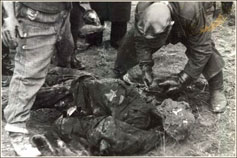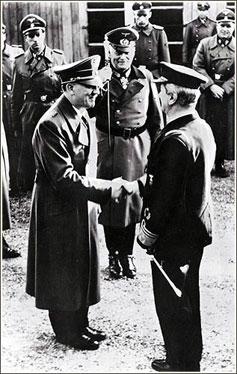For Any Inquries
Please contact:
Alycia Regan Benenati
Kasowitz Benson Torres LLP
1633 Broadway
New York, New York 10019
Tel. (212) 506-1975
Fax. (212) 500-3475
ABenenati@kasowitz.com
Lawsuit Background
Baron Mór Lipót Herzog assembled one of Europe’s great private collections of art and the largest collection in Hungary prior to World War II. However, the Herzog family’s legacy as patrons of the arts came to a sudden halt during the Hungarian Holocaust, when the Hungarian government, assisted by the Nazi regime in Germany, systematically annihilated its Jewish population and plundered its personal property and cultural treasures.
During the Hungarian Holocaust, which unfolded in a matter of months in 1944 and 1945, more than half a million Jews (nearly 75 percent of the Jewish population in Hungary) were detained, stripped of their possessions, and transported by Hungarian security forces to their deaths in German concentration camps or executed on the streets of Budapest. Herzog family members fled the country in order to escape the genocide, which was being carried out by Hungarian authorities with technical assistance by the Nazi SS. The Hungarian government had already enacted a law requiring Jews to deposit their art with the government for “safekeeping.” The Herzog Collection, one of the most splendid in Europe, was inspected personally by the notorious Adolf Eichmann, who designated certain works for shipment to Germany. Others were left in Hungary’s possession or looted by others.
After the war ended, Hungary resisted returning physical possession of the art to the Herzog heirs. It demanded exorbitant fees for storing and repatriating the art, denied export permits to the heirs living abroad, and harassed the family’s representatives in Hungary, including falsely accusing them of smuggling. Ultimately, the Herzog heirs had no choice but allow the Herzog Collection to remain in the custody of Hungary and its state-owned museums.
Hungary has made a mockery of the international agreements it has ratified to return property taken during the Holocaust. Hungary’s embarrassing and hypocritical actions stand in stark contrast to other European nations that have identified Holocaust art and returned it. In the spring of 2010, for instance, Germany returned a 16th Century masterpiece by George Pencz to the Herzog heirs. That work previously had been held in German museums and the museums, upon discovering the artwork’s origin, voluntarily returned it to the Herzog family.
Hungary, meanwhile, continues to ignore the practices of its European neighbors and has stonewalled the family’s attempts to recover possession of its property, thereby perpetuating the evils committed by Hungary during the Holocaust.
On July 27, 2010, heirs to the Herzog Collection filed a lawsuit against Hungary to seek the return of all of these artworks illegally held hostage by the government. The suit is widely regarded by art experts as the world’s last unresolved Holocaust art claim of this magnitude. The complaint involves over 40 works with a combined value of over $100 million, including masterworks by El Greco, Francisco de Zurbaran, and Lucas Cranach the Elder.
US Court Documents
- US Court of Appeals Opinion, Jun. 20, 2017
- Memorandum opinion, Mar. 14, 2016
- Court Order re Partial Denial of Motion to Dismiss, Mar. 14, 2016
- Plaintiff’s Supplemental Memorandum, Jan. 11, 2016
- Defendant’s Motion to Dismiss, May 14, 2015
- Defendants’ Supplemental Brief in Support of Motion to Dismiss, Dec. 22, 2015
- Defendants’ Reply in Support of Motion for Judicial Notice of Hungarian Laws, Sep. 15,2015
- Defendants’ Reply In Support of Renewed Motion to Dismiss, Sep. 7, 2015
- Plaintiffs’ Surreply, Jul. 17, 2015
- Plaintiff’s Unopposed Motion to Leave to File Sur-Reply, Jul. 17, 2015
- Defendants’ Brief in Support of Renewed Motion to Dismiss, Jul. 9, 2015
- Plaintiffs’ Opposition to Defendants’ Renewed Motion to Dismiss, Jun. 24, 2015
- Defendants’ Renewed Motion to Dismiss, May 18, 2015
- Defendants’ Motion to Dismiss, May 18, 2015
- Defendants’ Motion for Judicial Notice of Hungarian Laws, May 18, 2015
- Memorandum Opinion, Dec. 12, 2014
- Court Order, Dec. 12, 2014
- Defendants’ Supplemental Brief, Oct. 28, 2014
- Court Order for Supplemental Briefing, Oct. 20, 2014
- Reply Brief In Support Of Motion To Dismiss, Aug. 25, 2014
- Defendants’ Reply Brief in Support of Motion to Dismiss, Aug. 25, 2014
- Plaintiff’s Opposition to Defendants’s Motion to Dismiss, Jul. 25, 2014
- Defendants’ Answer to Complaint, Oct. 31, 2013
- Defendants’ Motion to Stay, Oct. 6, 2013
- Plaintiffs Opposition to Defendants’ Motion to Stay, Jun. 24, 2013
- US Court of Appeals Order, Apr. 19, 2013
- Plaintiff’s Response Brief, Jul. 27, 2012
- Memorandum Opinion, Sept. 1, 2011
- Order Granting Defendants’ Motion for Judicial Notice of Documents and Facts, Sept. 1, 2011
- Defendants’ Reply on their Motion for an order Granting Defendants’ Motion for Judicial Notice, Jun. 15, 2011
- Memorandum of Points and Authorities in Opposition to Defendants’ Motion for Judicial Notice, May 2, 2011
- Memorandum of Points and Authorities in Opposition to Defendants’ Motion to Dismiss, May 2, 2011
- Herzog Complaint, Jul. 27, 2010
Hungarian Court Documents
 Remains of a Hungarian forced laborer killed during the Holocaust.
Remains of a Hungarian forced laborer killed during the Holocaust.
 Miklós Horthy, the Regent of the Kingdom of Hungary and Nazi ally, greets Adolf Hitler in 1943.
Miklós Horthy, the Regent of the Kingdom of Hungary and Nazi ally, greets Adolf Hitler in 1943.
